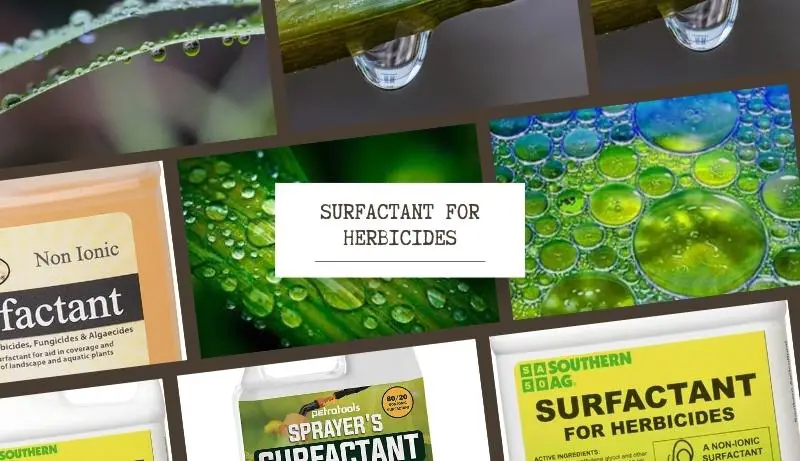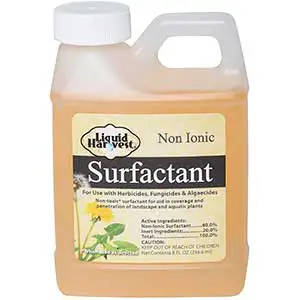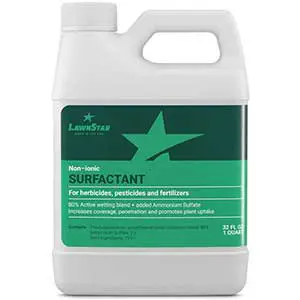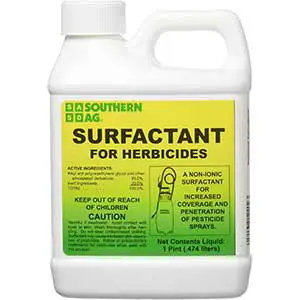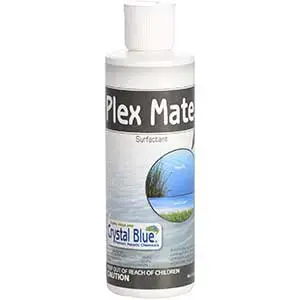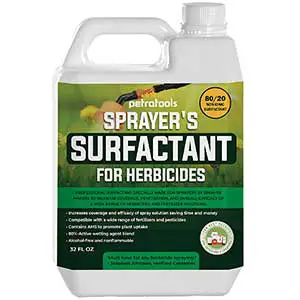Enhancing the effectiveness of herbicides is crucial for achieving desired results in weed control, which is why it’s important to find the best surfactant for herbicides. These agents play a vital role in improving the performance of herbicides by modifying spray solutions, enhancing its spreading capabilities, and ensuring better adherence to targeted plant surfaces.
In this article, we’ll take a look at the best products you can get – and we’ll tell you where you can get them for a fantastic price!
Best Surfactant for Herbicides Reviews
I’ve selected these products based on 20 years of groundskeeping and gardening experience and based on my own tests. If you somehow can’t find them, or they aren’t available, I suggest you inquire about products with similar components.
1. Liquid Harvest Non-Ionic 8oz Surfactant
Overall, the Concentrated Surfactant for Herbicides by Liquid Harvest is a versatile and highly effective tool. Its ability to increase herbicide effectiveness, improve coverage, and reduce wastage makes it a valuable asset for both homeowners and professionals. Just be mindful of potential package leakage issues and allow it ample time to deliver the desired results.
One of the standout benefits is its ability to enhance absorption, and it will make you forget about using dish soap or any similar compound that isn’t designed to be a surfactant for herbicides.
If you’re looking to get an effective surfactant at a very affordable price, then this Liquid Harvest product is the one that you’re after. I think it’s the best surfactant for herbicides that you can get online!
Pros
- Increased effectiveness in herbicide applications.
- Improved coverage for comprehensive weed control.
- Enhanced absorption for efficient weed management.
- Reduced wastage, saving time and money.
Cons
- Potential package leakage issue.
- Effectiveness may take longer to assess.
- INCREASE PRODUCT EFFECTIVENESS: Surfactants help herbicides to penetrate and spread evenly across the plant surface, increasing their effectiveness.
2. Southern Hag Non-Ionic Surfactant
The Surfactant for Herbicides by Southern Ag is an effective wetting agent designed to enhance the penetration, coverage, and overall effectiveness of herbicides. With its 80% non-ionic surfactant formula, it significantly improves the performance of various herbicide sprays.
In fact, one of the standout advantages is its compatibility with a wide range of herbicides, offering versatility for different weed control needs. It is important to check the herbicide product label for recommended surfactant usage.
Availability can be an issue, though, as it is not commonly found locally. Additionally, the price point may be slightly higher compared to other alternatives. Thankfully, it’s an easy product to buy online!
Pros:
- Enhances adherence and effectiveness of herbicides.
- Compatible with various herbicide sprays.
- Results visible in as little as seven days.
- Increases coverage and penetration for comprehensive weed control.
Cons:
- Limited availability in local stores.
- Relatively higher price compared to alternatives.
- Use with most pesticides to improve results
3. Liquid Harvest Concentrated Surfactant for Herbicides
The Concentrated Surfactant for Herbicides Non-Ionic Gallon by Liquid Harvest is an easy-to-use surfactant that greatly enhances the effectiveness of herbicides. This product allows herbicides, weed sprays, and other solutions to stick and spread evenly, ensuring comprehensive coverage.
I gave it a shot because I noticed that users had reported remarkable results with this surfactant. After testing it, I can confirm that it effectively improves the adhesion and spreading of herbicides, minimizing product waste in the long-run. You will notice a reduction in the amount of product required for spraying, making it a worthy investment.
The compatibility of this surfactant with herbicides such as Speed Zone is noticeable, and you can notice results as soon as the next day. This surfactant continued to perform exceptionally well even when facing rainy weather soon after applying it.
I didn’t have issues with it, although some users mentioned the need for slightly higher concentrations or extended timeframes for complete weed control. Nevertheless, it’s an extremely effective product.
Pros:
- Easy to use and compatible with various herbicides.
- Improves adhesion and spreading, reducing product waste.
- Shows quick results, even under challenging weather conditions.
- Cost-effective option for large yards or areas requiring extensive weed control.
Cons:
- Higher concentrations or prolonged application may be necessary.
- Weed control may take at least a week to fully manifest, depending on the weed and herbicide that you use.
- INCREASE PRODUCT EFFECTIVENESS: Surfactants help herbicides to penetrate and spread evenly across the plant surface, increasing their effectiveness.
4. Crystal Blue Plex Mate Aquatic Surfactant for Herbicides
The Crystal Blue Plex Mate Aquatic Surfactant is a valuable addition to any aquatic weed control regimen. Designed to enhance the effectiveness of herbicides and algaecides, this surfactant helps the chemicals stick to plant surfaces and break down the waxy coating found on aquatic weeds.
In my experience, and considering the experiences of others, I can say that it pairs well with products like Crystal Plex, Tsunami DQ, and Catt Plex, offering versatility for different applications.
The product can effectively clear treated areas within approximately two weeks, providing an easier alternative to manual weed removal methods. Importantly, it has proven to be safe for use around ponds, showing no harm to aquatic life.
You can expect good results when using this surfactant, although they can vary depending on your chosen herbicide and the general water conditions of where you apply it.
Pros:
- Enhances the effectiveness of herbicides and algaecides.
- Safe for use around ponds and does not harm aquatic life.
- Works well in conjunction with compatible products.
- Provides an easier alternative to manual weed removal.
Cons:
- Potential for loose caps causing liquid leakage.
- Results may vary depending on pond conditions.
5. Sprayer’s Surfactant for Herbicides – Non-ionic Surfactant
The Sprayer’s Surfactant for Herbicides by Petra is a powerful tool for improving the effectiveness of liquid solution applications. This surfactant allows herbicides, insecticides, fungicides, and fertilizers to penetrate plants more effectively, ensuring better coverage and results, as it is especially designed to achieve impressive results on waxy surfaces.
One of the standout features of this surfactant is its compatibility with PetraTools sprayers. That’s to be expected, as the product is developed by Petra themselves, but it’s still worth pointing out.
I’ve seen excellent results with this surfactant and other people report great results as well. It prevents solutions from sliding off, maximizing product usage and preventing wastage.
Additionally, the surfactant contains ammonium sulfate, which aids in nutrient absorption by plants, leading to healthier growth and reducing the need for excess fertilizers.
Pros:
- Enhances penetration and coverage of herbicides and other liquid solutions.
- Compatible with PetraTools sprayers for efficient application.
- Contains ammonium sulfate for improved nutrient absorption by plants.
- Helps herbicides and treatments stick longer, preventing wastage.
Cons:
- Limited information regarding specific weed species targeted.
- No notable disadvantages reported by users.
- Better Liquid Solution Application: PetraTools Sprayer’s Surfactant for Herbicides is formulated to allow solutions to penetrate the plants more effectively. It works by breaking down waxy surfaces for better liquid application. It’s ideal for use with weed killers and other herbicides, insecticides, fungicides, fertilizers, and many more.
Key Features of the Best Surfactant for Herbicides
Considering these key features will help you choose a product that enhances the effectiveness of your herbicide applications when selecting the best surfactant for herbicides. It’ll also give you a more profound understanding of why I’ve chosen the products listed above!
Check out the main features of a high-quality non-ionic surfactant for herbicides:
- Enhanced spreading and wetting. The best surfactant for herbicides should enable the solution to uniformly cover the target plant surfaces, ensuring maximum contact and absorption, even on the toughest of foliage. Look for surfactants that promote rapid and thorough coverage for optimal results.
- Reduced surface tension. A high-quality surfactant lowers the surface tension of the herbicide solution, allowing it to spread evenly and get through the targeted weeds in an effective way. Only good quality products are effective at reducing surface tension, which is why I consider it a defining factor of a good herbicide!
- Resistance against rain: A high-quality surfactant will make the herbicide remain effective even when exposed to rainfall. This is something to take into consideration if you live in an area with high humidity or where rains often come – it minimizes the risk of wash-off, providing longer-lasting weed control.
Anionic Surfactants vs Non-Ionic Surfactants
Understanding the differences between anionic and non-ionic surfactants is crucial if you aim to choose the best product that suits your needs.
This comparison table provides a concise overview of the key characteristics of these two types of surfactants. It’ll be practical if you’re still unsure about which type of surfactant to choose.
| Attribute | Anionic Surfactants | Non-Ionic Surfactants |
| Spreading/Wetting Ability | Spreading and wetting are a bit superior than in their non-ionic counterparts- | Good, but not great, spreading and wetting capabilities |
| Compatibility with Herbicides | More likely to become ineffective when combined with other surfactants | Compatible with most types of surfactants and unlikely to become ineffective |
| Stability | Less stable in hard water and acidic conditions | More stable in various water conditions and pH levels |
| Foam Formation | Likely to produce more foam | Generates less foam in most types of applications |
| Environmental Impact | Harmful to the environment | Much lower environmental impact |
With that said, keep in mind that anionic surfactants are generally cheaper than the best non-ionic surfactant. I still recommend you choose non-ionic surfactants if you want to stay green, or if you’re going to combine it with other surfactants.
How to Use Surfactants in Your Lawn
I imagine you’re looking for the best surfactant for herbicides because you already know how to apply it. However, let’s refresh the basic steps that you need to follow if you are to successfully use the best non-ionic surfactants in the most optimal way:
- Identify the weeds that you want to target. Survey your lawn to identify the specific types of weeds you want to control. Different weeds may require different herbicides and surfactants for optimal results.
- Prepare the herbicide solution. Mix the recommended amount of herbicide according to the label instructions of the product that you chose to buy. If the surfactant requires dilution, follow the specific surfactant’s instructions for proper dilution ratios.
- Add the surfactant once the solution is ready. Once the herbicide solution is prepared, add the recommended amount of surfactant. Please follow the instructions to the letter if you want to see optimal results. Follow what the label says.
- Apply the herbicide solution to the targeted weeds. Use a sprayer or a suitable application method to evenly apply the herbicide solution with the surfactant to the weeds. Ensure proper coverage of the weeds while minimizing over spray on desirable plants.
- Monitor the progress and evaluate the results. Observe the treated area over time to assess the effectiveness of the herbicide application – but don’t despair! Results may take a few days to notice the results.
While using herbicides and surfactants, wear appropriate protective clothing, including gloves, goggles, and long sleeves. Keep children and pets away from the treated area until it has dried completely.
When Should You Apply Surfactant to Herbicide?
Although it never hurts to add surfactant to herbicide if you are looking to enhance its effects, it’s not always necessary to do so. In fact, considering the extra cost of constantly purchasing surfactant, you may want to make a small plan of when it’s a good idea to apply get it. These are some scenarios where I generally use it:
- During rain seasons or when working in a humid environment, as a way to make the substance more effective.
- When the herbicide you have at hand needs a little push in effectiveness.
- When your herbicide doesn’t seem to be sticking to the surface of your plants appropriately.
Tips & Tricks for Applying Surfactant to Herbicide
By adhering to these guidelines, you can maximize the effectiveness of surfactants and achieve successful weed control. I always keep them in mind when applying surfactant to herbicide and when applying the herbicide itself:
- Read and follow label instructions for surfactant and herbicide.
- Choose a surfactant formulated for herbicide use – don’t just pick any surfactant!
- Use the recommended surfactant dosage.
- Mix surfactant and herbicide thoroughly to create a homogeneous substance.
- Apply when weather conditions are suitable. Avoid applying under rainfall.
- Apply with proper spraying technique for uniform coverage.
- Wear appropriate protective gear. Safety always comes first!
- Clean equipment after application to prevent cross-contamination.
- Monitor effectiveness and adjust as needed for future applications.
Essential Tools for Optimal Herbicide Performance
These tools not only facilitate accurate and uniform application of herbicides but also contribute to safety and efficiency. In this section, I will tell you all about the essential tools that are crucial for ensuring optimal herbicide performance:
- Sprayer: A quality sprayer is essential for applying herbicide solutions with surfactants. Choose a sprayer that is suitable for the size of your lawn or target area
- Measuring Container: This is necessary for accurately measuring the appropriate amount of surfactant to be added to the herbicide solution. This ensures proper dosage and helps achieve optimal performance.
- Mixing Stick or Agitator: A mixing stick or agitator can be useful to make sure that the substances are mixed appropriately. It helps blend the surfactant into the solution.
- Protective Gear: Wear protective gear, including gloves, goggles, long sleeves, and pants, to protect your skin and eyes from potential exposure to chemicals. Always prioritize your safety.
- Safety Sprayer Rinse System: This helps prevent contamination between different herbicides or surfactants and ensures proper maintenance and longevity of the equipment. Granted, this is even more necessary if you’re using anionic surfactants, but it’s still good to have when using the best non-ionic surfactants
Facts to Keep in Mind when Utilizing Surfactant for Herbicides
We will explore key considerations to bear in mind when utilizing surfactants for herbicides. By understanding these facts, you can make informed decisions and achieve superior outcomes in your herbicide applications. Let’s delve into the details!
- When selecting a surfactant, opt for the best non-ionic surfactant as it offers compatibility with a wide range of herbicides and ensures effective results.
- Proper timing is crucial when applying surfactant, as it should be mixed with herbicides according to the manufacturer’s instructions.
- Read instructions and feedback to ensure that your chosen surfactant is compatible with your herbicide.
- Consider the surfactant’s formulation and its ability to break down waxy coatings on target plants.
FAQs
What is a good surfactant for herbicides?
A good surfactant for herbicides is one that provides excellent spreading, wetting, and penetration abilities, enhancing the effectiveness of herbicides on targeted weeds. Be sure to get a surfactant that is compatible with the herbicide that you own, or vice versa.
Should you use a surfactant with herbicide?
Using a surfactant with herbicide is often recommended as it can improve the performance and efficacy of herbicide applications. Surfactants help the herbicide adhere to the target plant surfaces, ensuring better absorption and coverage.
What is the best surfactant to use with Roundup?
The best type of surfactant to use with Roundup is a non-ionic surfactant, such as the ones we’ve recommended in this article.
Can you use too much surfactant?
Yes, using too much surfactant can have negative effects. Excessive surfactant concentration can lead to phytotoxicity and cause long-term damage to your targeted plants. Be sure to use an appropriate amount, as shown in your chosen product’s label.
Is Dawn dish soap a surfactant?
Dawn dish soap can act as a surfactant due to its ability to reduce water surface tension. You should always consider that Dawn dish soap is not specifically formulated for herbicide use

David, the founder of The Garden Fixer, started with a passion for gardening in 2012. He has continued his passion for gardening and desire to improve his skills and wanted to share his journey and helpful knowledge with other like-minded individuals.
He launched The Garden Fixer as an outlet for those interested in learning more about Gardening in hopes they can take what they learn and apply it for themselves!
